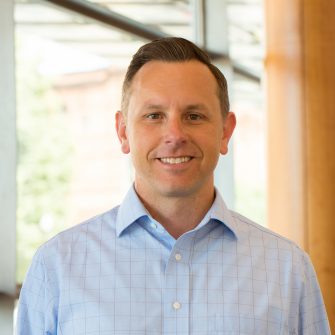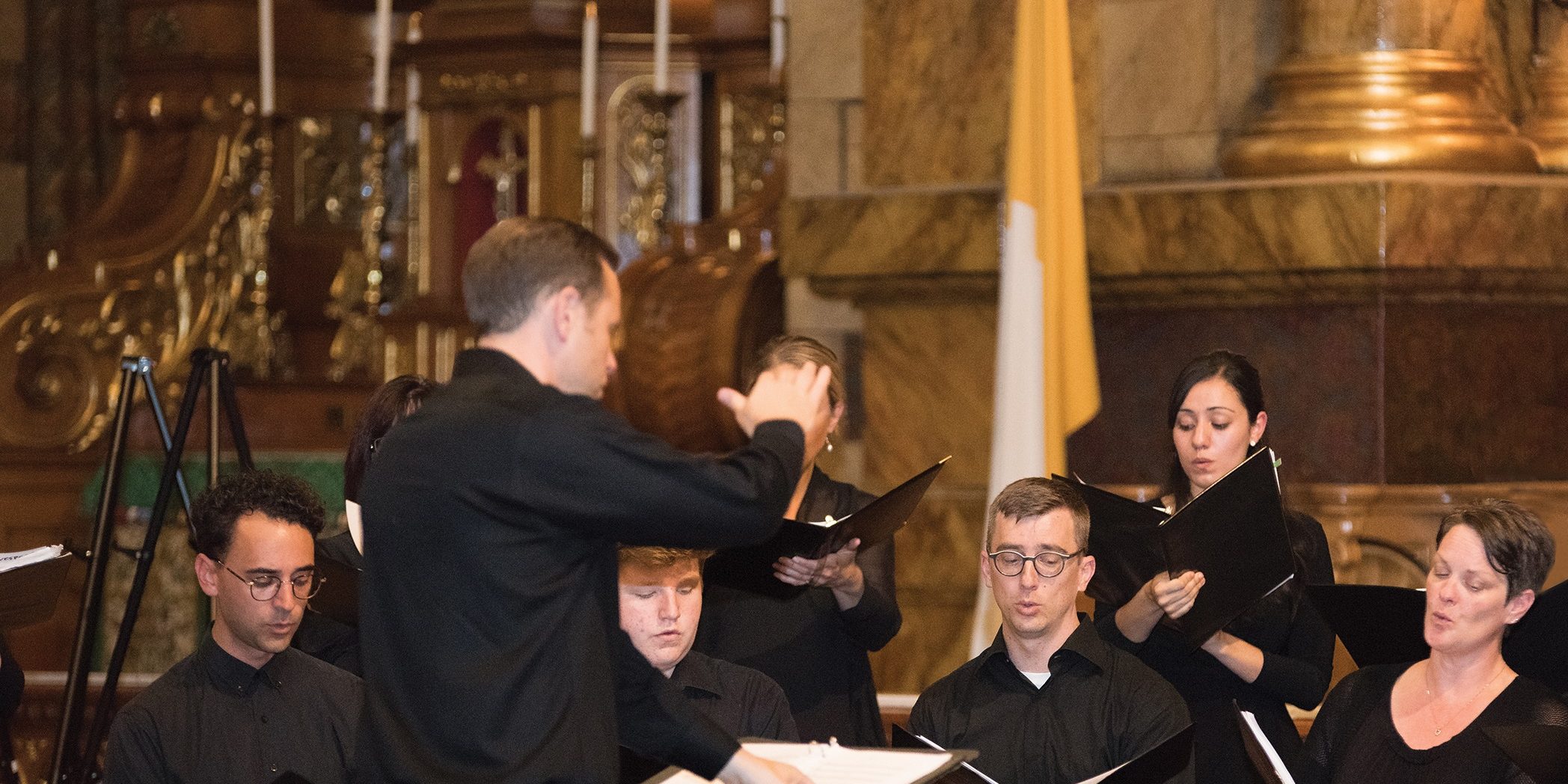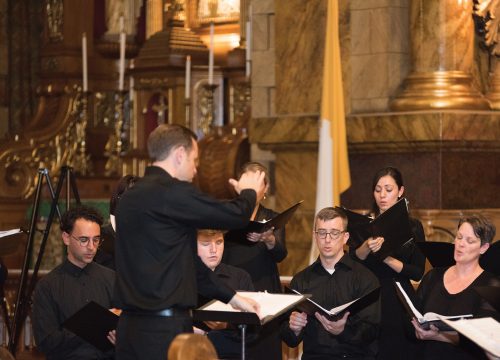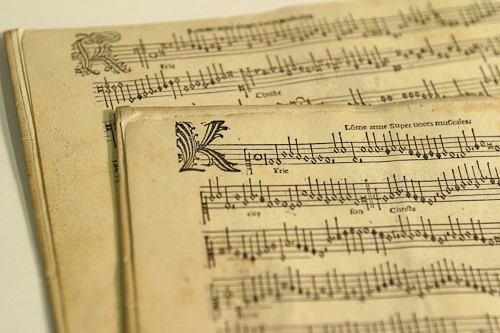 Associate Professor Michael Anderson
Associate Professor Michael Anderson
By Ashley Fong
Summer @ Eastman’s “Singing Gregorian Chant and Renaissance Polyphony” institute, led by Professor Michael Alan Anderson, will be held at a new location in 2020: Chicago’s Saint Clement Church. Now in its fourth year, this program attracts singers of all ages and backgrounds. In addition to technique study for singing chant and polyphony, participants learn about the history of notation, performance practice, and music theory. The class gives a public concert at the end of the week.
Summer@Eastman’s Marketing Assistant Ashley Fong interviewed Associate Professor of Musicology Michael Anderson to learn more about his musical and scholarly pursuits and how this institute came to be.
AF: Growing up, were you always interested in musicology and did you imagine yourself being where you are now?
MA: Definitely not. I played some piano by ear growing up – stuff I heard on the radio. My parents sang a lot. I started singing as a sophomore in high school and became passionate about that. I studied business administration as an undergraduate with a second major in music at the University of Notre Dame. I performed with the Chicago Symphony Chorus while working full time at an advertising agency. After a few years of that, I became dissatisfied with the musical experience. Although the chorus performed at a high level, I felt I wasn’t learning enough about the “what” and “why” of these concerts. We were like soldiers taking marching orders. That was the sign I needed to go back to graduate school to start to answer the questions I had.
AF: How did you first become interested in Gregorian Chant and Renaissance music specifically?
MA: My interest in Renaissance music started as an undergraduate. The director of the Notre Dame Glee Club gave us a motet and a chanson by Josquin des Prez, plus polyphony from the Mass by other Renaissance composers (Binchois, Moulu, Jacquet of Mantua, et al.). I was sold and had no clue who these composers were. Like many, I was transported when I heard the Hilliard Ensemble’s recording of Perotin.
My acquisition of chant came later. In 1998, I was singing some lightly-accompanied chant as a church cantor in Chicago, when one of my teachers at Notre Dame, Calvin Bower, was in attendance and asked if I’d like to learn more about chant. We started an early music ensemble, Schola Antiqua, which is still in operation today. The group became a laboratory for exploring plainchant of a wide variety with professional singers. Today, I direct the ensemble and we sing music of an ever-wider swath of history.
AF: In 2013 you received the University of Rochester’s Provost Multidisciplinary Award and this involved making first recordings of various pieces of medieval music. Could you share your experience making these recordings as well as collaborating with the Memorial Art Gallery?
MA: The medieval gallery of the Memorial Art Gallery was being reinstalled by my friend Nancy Norwood, the MAG’s curator of European art. She has always been interested in finding connections across the arts. This was a wonderful opportunity to look at the themes and particular objects on display in the new gallery and see what kind of music might relate to these things. I selected a “wish list” of pieces to record with my Chicago-based early music ensemble Schola Antiqua. With the grant from the provost’s office, we recorded those pieces and created an online exhibit called “Medieval Sights and Sounds.” Some of those pieces live on a touch-screen kiosk in the gallery still today, with further commentary on the intersections of visual art and music. I directed some of this music in a live performance at MAG with members of the Schola Cantorum of Christ Church. I used this experience as a springboard to projects with museums around the country, from the Art Institute of Chicago to the Metropolitan Museum of Art in New York.
Michael Anderson and singers from the 2017 institute, St. John Cantius Church, Chicago. Photo credit: Stephanie SeRine Photography
AF: You offer a week-long Summer institute on Gregorian Chant and Renaissance Polyphony. Who is this for: connoisseurs or beginners?
MA: The institute hosts many types of students with one thing in common—a genuine interest in Gregorian chant and/or Renaissance polyphony. Some of our students are church organists who want to get a no-nonsense refresher on plainchant. Others are choral singers who have had a little exposure to Renaissance polyphony but are eager to learn and perform more. We have had students ranging from high schoolers to senior citizens.
AF: Why did you choose Chicago as a location for this institute?
MA: I grew up in the Chicago suburbs and went to graduate school at the University of Chicago. I also have built relationships with people and institutions in the city through my work with Schola Antiqua. In 2017, we had a large, vibrant summer institute in Chicago; I look forward to something similar in 2020.
AF: Is there anything else people should know about your Summer institute?
MA: Although the course is called “*Singing* Gregorian Chant and Renaissance Polyphony,” we do not sing for seven hours per day! We have a little bit of lecture mixed in with all the singing we do on topics ranging from history and notation to performance practice and music theory. We do have an official “rehearsal” each day in preparation for a public concert we present at the end of the week.
AF: Your list of accomplishments and current activities goes on and on: case studies, articles, and books you’ve written, along with leadership positions in ensembles and organizations. How do you balance everything?
MA: I don’t think all of these things are in balance, but I generally enjoy the things I am challenged to do and the freedom I have to do them. Deadlines seem to dictate everything, but I also try to live by the advice that it’s not too early to start a project. As it applies to writing in particular: “write before it is time to start writing.”
Singing Gregorian Chant and Renaissance Polyphony runs August 3-7, 2020 at Saint Clement Church, Chicago. Registration is open now.
Manuscript from Sibley Music Library. Photograph by Kurt Brownell


